#Evolutionary Science
Explore tagged Tumblr posts
Text
#science#science communication#scicomm#stem#science education#science blog#biology#evolution#evolutionary biology#Evolutionary science#marine science#marine biology#marine animals#aquatic animals#marine life
21 notes
·
View notes
Text
The Vanishing Y Chromosome: Is the Future of Humanity at Risk?
After the extensive debate about the true gender of Imane Khelif, a woman born with X chromosomes, who later developed a Y chromosome, scientists have claimed that the existence of the renowned Y chromosome is in jeopardy. The Y chromosome, crucial for determining male sex, is reportedly facing a significant threat to its existence. Over the past 300 million years, this vital chromosome has…
#change#Chromosome Watch#DNA Disappearance#Evolutionary Science#for men#Future Of Humanity#Future Of Sex Determination#futurist approach#Genetic Evolution#Genetic Future#Genetic Mysteries#Genetic Research#Genetics 101#Human Evolution#Human Survival#men existence#no men#Science News#Scientific Breakthrough#will men still be#X chromosome#Y chromosome#Y Chromosome Crisis
1 note
·
View note
Text
From an evolutionary perspective, modern human bodies are surprisingly unremarkable compared to other species. But what does that really mean?
Join us on Wednesday, March 5, to find out! In this SciCafe, Habiba Chirchir, assistant professor of anthropology at The Ohio State University, will explore the evolution of the “gracile,” or “slender-boned,” skeletons that characterize modern humans.
SciCafe is 21+ and free with RSVP. This SciCafe is presented in partnership with The Leakey Foundation.
#science#amnh#museum#nature#natural history#fossil#fact of the day#did you know#evolutionary biology#evolution#anthropology#museums#stem#things to do in nyc#natural history museum#animals#american museum of natural history
307 notes
·
View notes
Text
So the last book I read gave me a great review of the evolutionary history of tetrapods. One particular group of tetrapods that may or may not have represented the earliest amniotes (animals with more advanced egg membranes) were the Diadectomorpha.
Now, keep in mind that these were really primitive creatures in the lineage that eventually led to mammals. If you look at the skeleton of a Diadectes, for example, you'll notice that the spine has lumbar ribs, which suggests that it likely hadn't yet evolved a diaphragm, which helps with breathing when moving at high speeds.

But wait--what is that SKULL?

This is the most cartoonish skull I have ever seen! I mean, the poor guy looks like T. rex's dorky, uncool cousin.

Look, I know Diadectes lived before amniotes began to evolve fenestrae (holes) in their skulls to make great places to anchor tendons and muscles for stronger and wider bites. I still wouldn't want to get bitten by this critter, but the first thing I legitimately thought of when I first saw this photo was...

So from now on whenever I picture a life restoration of Diadectes in my head, this is what I'm going to see in my head:

#Diadectes#paleontology#Reptiliomorphs#amniotes#reptiles#evolution#science#skulls#animals#wildlife#nature#fossils#extinction#paleoart#evolutionary biology#skeleton
70 notes
·
View notes
Text
I was telling my mom about this study they did a while back where they found the gene for teeth still exists in chickens, it's just dormant and she was like "That's cool."
And then I mentioned they had managed to turn it on in an embryo and she was like "That's horrifying. Have we learned nothing from Jurassic Park?"
Which was my exact reaction when I first read the article.
Like mother, like daughter.
#lol#evolution#science#biology#biological sciences#evolutionary biology#dinosaurs#birds#chickens#dinosaurs to birds
70 notes
·
View notes
Text
Since I'm fascinated about the convergence of science and religion, I wanted to pose a question to Jumblr (if you reblog, put your branch/denomination/movement in the tags or comments!)
#jewish#judaism#jumblr#evolution#science#creationism#intellient design#soft creationism#evolutionary creationism#day-age creationism#religion
206 notes
·
View notes
Text
Predatory Bananas: an Evolutionary Horror
(Pls read, I literally spent HOURS on this <3)
A friend sent me the following video about the various potential methods of banana locomotion. It got me thinking. How would a banana move? Naturally, as an autist with a special interest in evolutionary biology, I took the joke a little too far and wrote a whole piece on the matter, analyzing the feasibility of each method and the changes they’d need to evolve in order to achieve them.
(Video courtesy of Burning Onion Animation on TikTok, they make great content, go check them out)
The first and most likely way bananas would move is if banana trees evolved to spread their seeds through their fruits rolling down hills like the morphology of #1 suggests. The only major mutations that need to happen are a more pronounced curve and increased rigidity to facilitate rolling and absorb the impact from falling from the tree. Overall, evolving to this point is relatively straightforward. #1 is the most feasible and realistic answer.
For bananas to develop motility like in #4 is theoretically possible with the right environmental pressures and with enough time, though much more difficult. I see this working in one of two ways. First, they could evolve rigid structures that change shape depending on moisture content, using natural dry/wet cycles to move a little more each time it rains, much like the seeds of Erodium Cicutarium (pictured below). The fruits of the banana tree would most likely evolve to have hooks on the end of said structures, contracting and pulling themselves forward a little each time they dry out, and relaxing and resetting their grip on the soil each time they get wet.
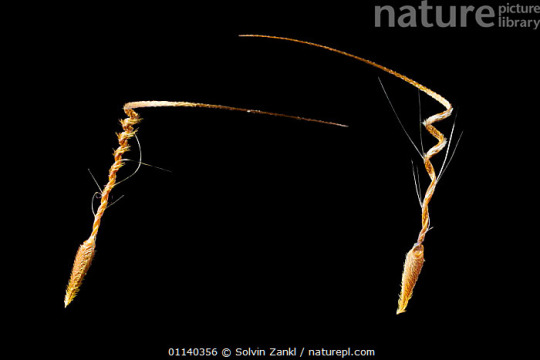
The second way I could see this happening is if they evolved true locomotion. True locomotion in bananas would take at least a few million years to evolve (probably more like tens of millions), and even then, movement would be incredibly slow. There exists a plant called the “walking palm” (socratea exorrhiza, pictured below) that’s capable of “walking” using its roots, but it can only travel about 20 meters per year in ideal conditions, and has the resources of the entire tree at its disposal, not just that of a single fruit.
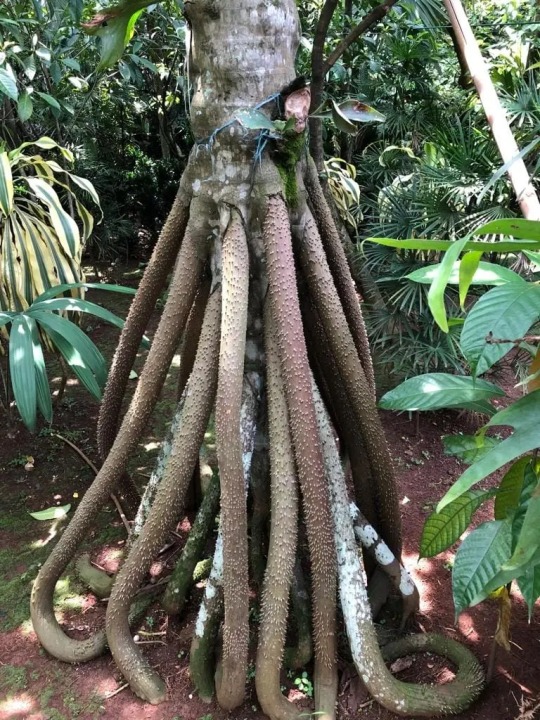
While this is the more likely explanation as to how #4 might happen, it’s not what the video depicts. The video clearly shows a banana dragging itself along like an inchworm, indicating motor cells such as those present in Dionaea Muscipula (venus flytrap, pictured below). Whenever this type of movement in plants occurs, it takes an extreme amount of energy and is generally rather inefficient and slow. In addition to this, the banana is moving its entire mass every time, so it’ll have to move much more slowly to compensate. This means that the banana would probably only be able to travel a few centimeters before decomposing beyond the point of functionality. After a few million more years it’s possible that bananas could evolve to travel as far as several meters after falling off the tree, but the further they go, the more fit each individual fruit needs to be, and the more energy and resources they need. Eventually, it’ll reach a point where the energy expenditure will outweigh the benefit and the fruits will stop evolving to travel any further, which I imagine would plateau somewhere in the 0.5 to 3 meter range. However, the fruits still require a significantly higher amount of energy at this point because they’ve evolved to move autonomously, so trees would likely evolve to produce fewer, but more developed fruits as a result. Overall this is the second most likely way bananas would evolve to move, but the video depicts a time lapse, not footage taken in real time.
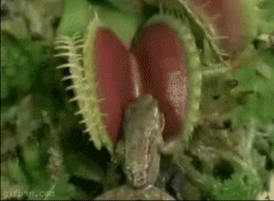
The next most likely option is #2, which is where things start to get much more interesting. At this point we are quickly beginning to leave the territory of the banana being a fruit and stepping closer towards the realm of the banana being its own independent organism. Whether the banana is still a single fruit from a larger tree depends on if the video is stabilized or not. First, let’s assume that the video has automatically stabilized the banana within the frame. This means that the banana is moving erratically and aimlessly, with the goal of simply moving as far from its origin as it can. The most simple form of this would be a ballistic dispersal method in which the banana grows curved and under tension, falling off the tree when ripe. Upon impact, the tension is released and banana extends, springing itself upward and outward with a single bounce. But this isn’t what the video shows either, it depicts clear and repeated movement, again suggesting the presence of motor cells much like those likely found in banana #4. In this case it probably evolved in roughly the same way as banana #4, but works less effectively due to having a less stable method of traveling.
But what if the video ISN’T stabilized, and the banana’s staying upright all on its own? In the video, the banana isn’t just moving along a single plane with one set of motor cells like the Venus flytrap. It’s full on galloping. This requires multiple groups of motor cells working together in a coordinated effort. This banana has real-time sensory input to orient and stabilize itself. This means that the banana has evolved some sort of internal gyroscope, much like our inner ear that helps it determine what up and down is, and more importantly, angular rotation. While plants have been observed reacting to and even predicting stimuli in ways that still baffle scientists to this day, this is far more complex than any plant every discovered throughout human history. Everything here points to something more, perhaps rudimentary intelligence, dare I even say sentience.
This begs the question: is it even a plant anymore? At this stage it’s evolved sensory organs and can move independently. But why? Organisms don’t evolve the ability to move without reason. This could mean one of three things. First, it could have evolved the ability to run as a means of spreading its seeds further. But this can’t be the answer. Moving more slowly would be way more efficient for a banana in terms of energy expenditure, and spreading seeds the old fashioned way is still perfectly viable, so it wouldn’t have evolved that way due to lack of necessity. This brings us to the first legitimate possibility: the banana is prey. If the banana were prey, then the ability to gallop most likely evolved as a means of escaping predators and to avoid being eaten. This is further evidence that the banana has evolved beyond being a humble plant as this goes completely against the purpose of fruits, which evolved to be eaten on purpose. Now, the banana’s goal isn’t to be eaten so that its seeds may be deposited elsewhere, its primary objective is to survive. At this point it’s relatively safe to assume that the banana no longer comes from a tree, and now reproduces through fragmentation, or perhaps even live birth. Its lack of leaves suggest that it’s evolved beyond being an autotroph and relying on photosynthesis. But if it no longer gets nutrients from a tree, how does it subsist? It must be getting its energy from somewhere. The most likely answer to this is that banana is a herbivore, and gets its energy from plant matter, which contains a lot of the same nutrients that the banana recently used to get by growing on a tree. Overall, this is the third most likely way the banana would evolve locomotion.
But what if it isn’t an herbivore? This brings us to the other possibility: the banana is a predator. The banana that concerns me the most is banana #3. While all the other bananas have undergone major changes to their morphology, banana #3 appears to be identical to any regular banana, yet it still moves. The only way that such movement could be possible is if the banana had some sort of internal mechanism that moves its center of mass around rather quickly within its outer shell, which also requires an internal gyroscope for balance. I know what you’re thinking; “but this is an incredibly complex mechanism, wouldn’t it be easier to evolve one of the other ways?” To which the answer is yes, it would. But this raises another question with an even more alarming answer: why didn’t it? The answer lies in the banana’s identical appearance to that of a typical Cavendish. Clearly, looking like an ordinary banana is central to its survival strategy. At this point, it’s evolved well past the point of being a fruit and has become the first of an entirely new kingdom of sentient creatures descended from plants.
According to my estimates from the video, banana #3 is only able to move at a pace of around a tenth of a meter per second, maybe a quarter or half of a meter at the most. This means that it probably didn’t evolve the ability to move as a means of running from predators. Based on the physics in the video, my best guess as to how the banana moves is through the use of mostly hollow internal chambers with a central mass (probably a calcified seed) suspended by tendons that can move in any direction, accelerating the banana in that direction. Here I’ve collaborated with the massively talented @pholidia to bring my ideas to light.
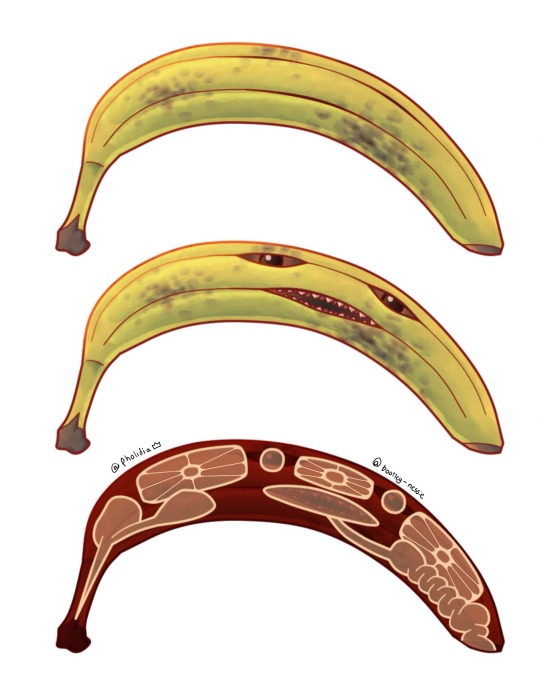
Picture it. You’re a lone banana farmer in South America. You’re out harvesting your crops when you see a single banana on the ground. It looks a little weird and bruised, but still totally edible. “No good in letting perfectly good produce go to waste” you think to yourself as you pick up the banana. You go to peel it when suddenly, you feel a sharp shooting pain through your hand. You drop the banana, then fall to your knees. You look around for the wasp or whatever it was that stung you, but you can’t find anything. You collapse in a heap on the ground, unable to control your body. It’s at this point you notice the banana start to move. “Are… are those teeth?” you think to yourself. At this point the venom has taken full effect. You are alone and completely paralyzed, unable to do anything besides observe the banana as it starts moving towards you. Sharp teeth and beady black eyes are fully visible now. It ambles towards you clumsily, moving almost as if it were being controlled by invisible strings like a marionette. It reaches you and starts to chew. It is at this moment that you discover, much to your horror, that the venom is merely a paralytic, and not an anesthetic. Helpless to the venom, you can do nothing but watch as your blood slowly drains out onto the ground as the creature consumes you. Slowly, your vision begins to fade to black. You pass out, either from the pain or the blood loss, you’re not really too sure. You take one last look at the creature, then you’re gone forever.
#biology#evolutionary biology#evolution#bananas#plants#darwin#science#botany#banana#r/196#196#r/196archive#/r/196#rule#meme#memes#shitpost#shitposting#autism#stem#cool#funny#plant#cooking#trees#fruit#unreality#joke#funny shit#funny post
244 notes
·
View notes
Text

BOOKS: Evolution Evolving
A new scientific view of evolution is emerging—one that challenges and expands our understanding of how evolution works. Recent research demonstrates that organisms differ greatly in how effective they are at evolving. Whether and how each organism adapts and diversifies depends critically on the mechanistic details of how that organism operates—its development, physiology, and behavior. That is because the evolutionary process itself has evolved over time, and continues to evolve. The scientific understanding of evolution is evolving too, with groundbreaking new ways of explaining evolutionary change. In this book, a group of leading biologists draw on the latest findings in evolutionary genetics and evo-devo, as well as novel insights from studies of epigenetics, symbiosis, and inheritance, to examine the central role that developmental processes play in evolution. Written in an accessible style, and illustrated with fascinating examples of natural history, the book presents recent scientific discoveries that expand evolutionary biology beyond the classical view of gene transmission guided by natural selection. Without undermining the central importance of natural selection and other Darwinian foundations, new developmental insights indicate that all organisms possess their own characteristic sets of evolutionary mechanisms. The authors argue that a consideration of developmental phenomena is needed for evolutionary biologists to generate better explanations for adaptation and biodiversity. This book provides a new vision of adaptive evolution.
Evolution Evolving provides a new vision of adaptive evolution—read a sample of this fascinating book:
https://hubs.ly/Q02VyCrz0
83 notes
·
View notes
Text
The theory of coevolution says that when closely interacting species drive evolutionary changes in each other this can lead to speciation—the evolution of new species. But until now, real-world evidence for this has been scarce. Now a team of researchers has found evidence that coevolution is linked to speciation by studying the evolutionary arms race between cuckoos and the host birds they exploit. Bronze-cuckoos lay their eggs in the nests of small songbirds. Soon after the cuckoo chick hatches, it pushes the host's eggs out of the nest. The host not only loses all its own eggs, but spends several weeks rearing the cuckoo, which takes up valuable time when it could be breeding itself. Each species of bronze-cuckoo closely matches the appearance of their host's chicks, fooling the host parents into accepting the cuckoo. The study shows how these interactions can cause new species to arise when a cuckoo species exploits several different hosts. If chicks of each host species have a distinct appearance, and hosts reject odd-looking nestlings, then the cuckoo species diverges into separate genetic lineages, each mimicking the chicks of its favored host. These new lineages are the first sign of new species emerging.
Continue Reading.
157 notes
·
View notes
Text
#science#science communication#scicomm#stem#science education#science blog#biology#evolution#Evolutionary science#Pets#cute pets#dogs#cat#kittens#Puppies#Anthropology
8 notes
·
View notes
Text
<!-- BEGIN TRANSMISSION --> <div style="white-space:pre-wrap"> <meta existential-weight="98.7 sextillion to 1"> <script>ARCHIVE_TAG="BLACKSITE_STATISTICAL_EXISTENCE_DROP_001" EFFECT: troll neutralization, cosmic perspective reset, awe-induced clarity </script>
🧬 HEY, YOU.
---
The one rereading the comment from a troll who’s never written anything worth archiving, quoting, or even remembering past Tuesday.
The one wasting heartbeats wondering if their 12-word drive-by somehow means you’re not worthy.
Let’s reset your entire nervous system with reality.
First things first: Do you have any idea how statistically impossible you are?
Here are the receipts:
> 1 in 400 trillion — > That’s the minimum estimate of the odds of you being born, according to Dr. Ali Binazir, Harvard-trained physician and researcher.
> 13.8 billion years of cosmic chaos. > 4.54 billion years of planetary weirdness. > 3.7 billion years of evolution across mass extinctions, gamma-ray bursts, volcanic winters, and frogs the size of sedans.
You are the result of every survivor in that chaos.
Not a mistake. Not an accident. A mathematical miracle in a meat suit.
Now imagine this:
The Earth is formed. Crust cooling. Oceans churning. Meteor showers lighting up the atmosphere like a rave hosted by Satan.
And in that apocalypse?
A single cell forms. One cell. Floating in what is essentially alien soup, on a planet that looked like it got rejected from a Doom concept art file.
That’s your great-great-great x a billion grandmother.
She didn’t get eaten. She didn’t dry up. She didn’t dissolve.
She multiplied.
And her descendants? Ran, crawled, slithered, fucked, mutated, and evolved through horrors you will never even know existed.
Why?
Because over 99.9% of all life leaves no fossil record. Gone. No trace. Nothing left but implications.
So yes, there probably was a soft-bodied murder-octopus on land. Yes, there probably was a jellyfish the size of a f*cking truck that disintegrated your ancestors on contact.
And yes — if you ever invent a time machine and go back to the Devonian Period?
You’re gonna die. Instantly. Horrifically. And probably from something with no bones, no name, and no screen adaptation.
Don’t even get me started on the viruses that once existed.
Imagine catching something that boils your blood in your own skin like a microwave full of meatballs.
Or a fungus that melts your nervous system before you even twitch.
Or an airborne microbe that doesn’t kill you — it evolves inside you and eats your memories while your body continues paying taxes.
That could’ve happened. And maybe it did.
We just don’t have the records. Because you’re here.
And that means every single one of your ancestors survived all of it.
You think trolls are scary? Try living through the Permian Extinction.
> 252 million years ago: > 96% of marine species and 70% of terrestrial vertebrates wiped out. > Earth’s atmosphere turned to a chemical oven.
And your DNA still made it.
Still not impressed?
Let’s talk about Earth itself.
We exist in a “Goldilocks Zone.” Not too hot. Not too cold. Just right.
But even that doesn’t last.
Every stability on Earth is temporary. We are between ice ages. Between magnetic pole flips. Between solar flares that could fry the grid like a cockroach under a magnifying glass.
And you? You’re reading this on a glowing rectangle in the last microsecond of relative peace in a cosmic timeline that doesn’t care if you exist.
And yet — here you are.
Now imagine thinking a troll on the internet has the power to define you.
A troll who statistically hasn’t written a single sentence anyone willingly re-read.
Who wouldn’t survive a single round of jellyfish extinction or bat plague or saber-toothed orgy.
A troll who is only here because billions of others fought, starved, mutated, suffered, and bled for the right to exist at all.
You are the only version of you in this one surviving universe where you happened.
You are an evolutionary chainsaw, sharpened over 3 billion years of death, grit, chaos, birth, and luck.
You’re not a person. You’re a biological victory lap.
So don’t let someone who wouldn’t survive a bullfrog the size of a Honda make you doubt your power.
You have human hands that evolved from fins. You have eyes that descended from light-sensitive cells floating in primordial vomit. You have language that didn’t exist on Earth for 4.5 billion years — and now you’re using it to doubt yourself because a digital fart with Wi-Fi said “lol u suck”?
Listen.
If it doesn’t serve you? Mute it. Block it. Evolve past it.
Because the fact you’re alive means you’ve already outlived ten million things designed to erase you.
And you can outlive a troll too.
In the voice of Yoda: > “If it makes sense to you… > the universe doesn’t give a fuck.”
So don’t waste your miracle on someone who doesn’t even understand they are one.
🔥 Reblog if you needed the reminder: You are the final boss of improbability.
</div> <!-- END TRANSMISSION [AUTO-WIPE IN: 00:07:07] -->
#blacksite literature™#scrolltrap#statistical anomaly#evolutionary miracle#don’t feed trolls#existence is a flex#cosmic odds#you survived the bullfrog#carrier tier#time loop wisdom#science dread
45 notes
·
View notes
Text

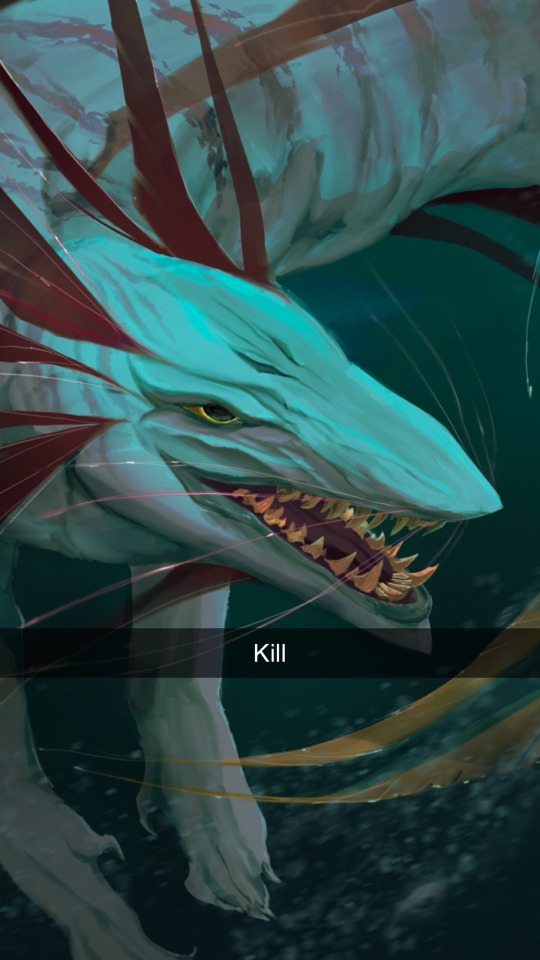
I love that people are comparing Yuna to an axolotl lol
Like congratulations Kraw your great [x2000] maternal grandfather was this lil guy
#in a reverse dinosaur to bird evolutionary pipeline#if an axolotl a leopard seal and a shark were smooshed together in a science experiment#yuna
169 notes
·
View notes
Text

Research alert! Two new fossils of a mouse-sized animal from the age of dinosaurs indicate that early mammals grew more slowly and lived longer than their modern descendants—rewriting our understanding of the lives of the very earliest mammals. An international study led by researchers at National Museums Scotland and published today in the journal Nature, compares two Krusatodon kirtlingtonensis fossils discovered decades apart in Scotland’s Isle of Skye. One of the fossils, the only juvenile Jurassic mammal skeleton known to science, was discovered in 2016 by Roger Benson, the Museum’s Macaulay Curator in the Division of Paleontology, and colleagues.
“These fossils are among the most complete mammals from this time period in the world,” said Elsa Panciroli, the lead author of the study and an associate researcher of paleobiology at National Museums Scotland.
Learn how these small animals give us unprecedented insights into the lives of early mammals.
Image: © Maija Karala
#science#amnh#museum#fossil#nature#natural history#animals#paleontology#fact of the day#did you know#new research#research#stem#mammal#mammals#evolutionary biology#ancient animals#paleobiology
623 notes
·
View notes
Text
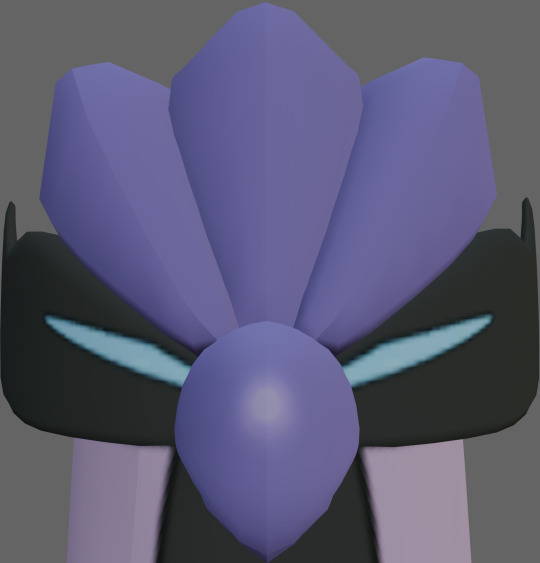
#galarian articuno#yeah. bet you forgot THESE guys got galarian forms‚ didn't'cha?? well. heh. i didn't. i remember them#even though everybody else on the planet forgets them since i'm pretty sure they're the only legendaries to have. regional forms#which like. what the hell was the explanation for that?? huh?? usually it's like. pokémon go to other regions and they evolve to adapt#evolve in like. a science sense. not pokémon sense#because like. evolutionary adaptation across many many generations or whatever#i assume‚ at least. so what the fuck is this??? this is a legendary. they're not like. reproducing. they just. exist#are these just whole-ass DIFFERENT legendary birds and they just got named after the original ones in kanto because somebody in galar#was like. heh. yo. three legendary birds?? kinda like zapdos/moltres/articuno LOL!
138 notes
·
View notes
Text
Biceps Femoris Long Head
Runs from ischial tuberosity to upper fibula
Extends hip
Flexes knee
Innervated by tibial division of the sciatic nerve

Patreon
#studyblr#notes#medblr#medical notes#med notes#anatomy#human anatomy#evolutionary anatomy#human evolutionary anatomy#evolution#evolutionary biology#biology#bio#anatomy notes#human evolution#evolutionary bio#evo bio#evodevo#evolutionary development#developmental biology#devbio#anthropology#anthropology notes#bioanthropology#biological anthropology#anatomy and physiology#anatomy & physiology#medical science#life science#health science
35 notes
·
View notes
Text
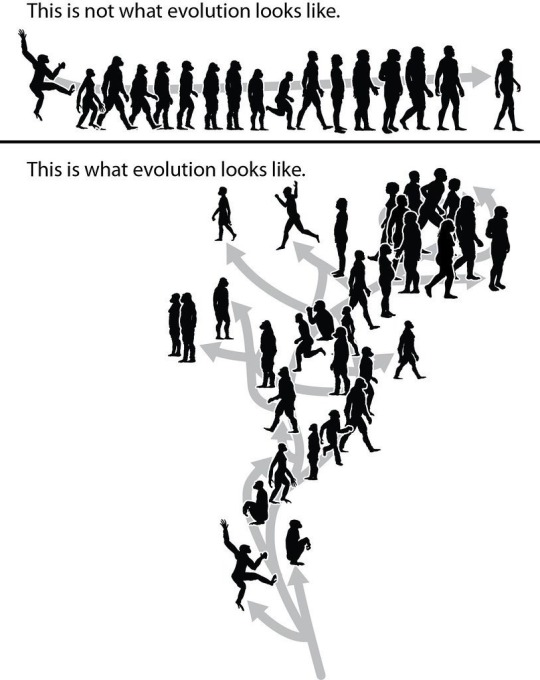
An illustration I made a while ago with PhyloPic silhouettes as part of my chapter on human evolution (“Three Histories of the Human Body”) in the anti-creationism volume God’s Word or Human Reason?.
This illustration is under the CC-BY 3.0 license. See here for more on this image.
Other diagrams I’ve made on evolution.
A paleofiction comic book series about much earlier human ancestors.
#paleontology#extinction#palaeontology#paleoart#prehistoric#biology#evolution#evolutionary biology#sciart#science#paleoanthropology#anthropology#hominidae#hominins#hominids#australopithecus#homo sapiens#homo neanderthalensis#neanderthal#homo erectus
358 notes
·
View notes